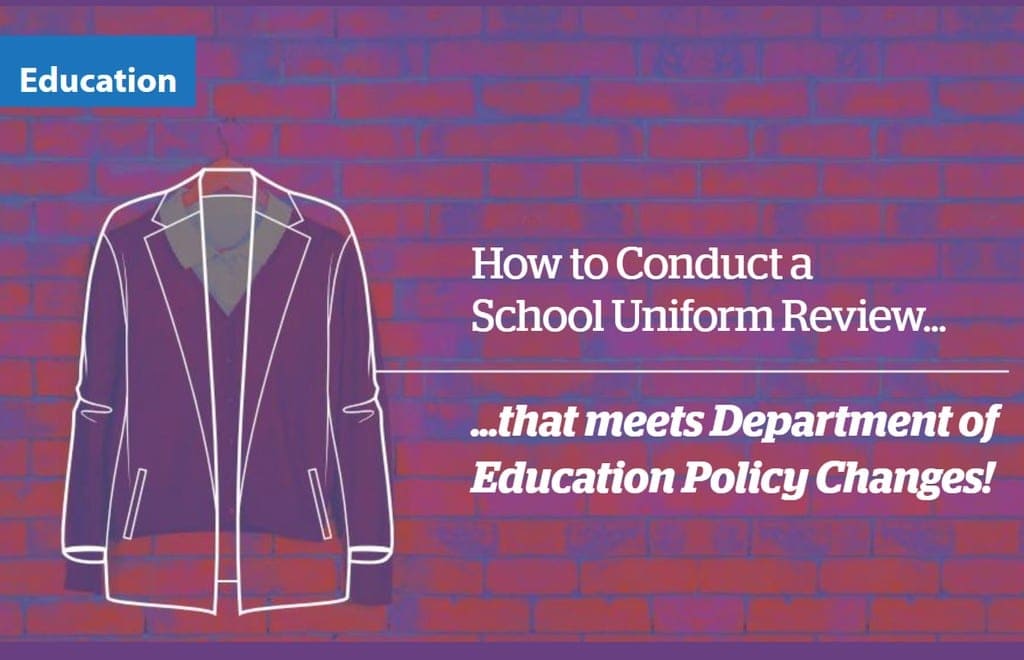Across Australia, many primary and secondary, state and private schools are doing school uniform research because they are reviewing and ‘modernising’ their school uniform. This is due to changing community expectations about what children should wear to school.
If your school is looking to update its school uniform, here’s the school uniform research that you need to know:
Queensland’s Student Dress Code Policy
Get a copy of the Queensland Department of Education School Dress Code policy. Whilst only state schools are bound to comply, all schools should consider aligning with this document. It is designed to respect the rights of students and schools. After looking at school uniform research and engaging in community consultation, the Department of Education updated the Student Dress Code on the 13th July 2018. The policy states that individual schools’ Student Dress Codes must:
- be developed in consultation with the school community
- be consistent with health and safety considerations
- comply with anti-discrimination legislation
- consider affordability, functionality and durability of uniform items
- provide uniform options, including shorts and pants, in all uniform categories for all students, regardless of gender.
Following this new Student Dress Code will ensure schools uphold anti-discrimination and equal opportunity legislation and lessens the possibility that students and parents will challenge the school dress code on discrimination and legal grounds. Using the Education Departments detailed checklist (found at the bottom of their official policy) will help step you through a successful uniform review.
The weather & school uniforms
In Queensland, spring and summer get very hot, and all students (male and female) need shorts available that are cool and comfortable. Similarly, some of our winter days can be extremely cool, and all students should have the option to wear comfortable long pants. For many schools, their school uniform has seen the wearing of shorts and pants limited to boys’ uniforms. An easy way to modernise the school uniform is to add girls’ shorts and pants to the uniform policy. Similarly, allowing students to wear shorts or long pants at any stage of the year based on whether the individual feels hot or cold is a sensible position.
Student comfort in the school uniform
Several schools have modernised their school uniform by allowing students to choose from a range of uniform options and removing the requirement that boys wear ties and long socks, and girls wear skirts and dresses. Placing the comfort of students as a key consideration when redesigning your uniform will help you design a uniform that supports the range of activities modern students engage in each school day, not just during sport.

Modern fabric and style
Fashions change with time, and while your school uniform does not need to respond to every fashion trend, it should include a range of options, be made of materials, and be in the colours, that young people want to wear. Choosing breathable, stretchy and natural materials with high S.P.F. protection, in basic colours, adds to student comfort and makes items easier to launder and maintain. Creating a uniform that reflects how students dress outside of school, and one that students like, goes a long way to ensuring that they will wear it, and wear it properly, reducing the many uniform infractions schools deal with daily.
Cost and availability of the school uniform
Choosing colours that are widely available ensures the cost is kept down if parents can buy generic versions at local stores. Consider making all school uniform options available for all students to wear and check that the cost of male and female versions of these options are similar. Ensure all options, such as long pants for girls, are part of the formal uniform list and can be worn for formal occasions, allowing girls to avoid having to purchase an additional skirt or dress for formal occasions. If your uniform shop has limited space, consider choosing a uniform supplier that will hold extra stock for you at their premises free of charge, so you can easily and quickly access the range of options available for your students.
Gender equality and gender labels
Consider whether your uniform policy needs to have “Girls Uniform” and “Boys Uniform” as headings. Can your school provide a range of suitable options that all students can wear which can be listed as “Student Uniform”? If doing this, do remember that girls are unlikely to want to wear shorts or pants that boys have been wearing for decades, as these will be viewed as ‘boys shorts or pants’ (just as boys are unlikely to want to wear the ‘girls shorts’). Where possible, ensure girls’ and boys’ options of all choices are available, and students are free to choose whichever of these versions they feel most comfortable wearing. As girls and boys are encouraged inside and outside of school to challenge gender stereotypes and develop to their full potential, it is important that the uniforms we offer them move away from applying strict gender restrictions.

Communication of changes and updates to the school uniform is key
When it comes to modernising the uniform worn by students at your school, good communication will be crucial to having a smooth change process. The principal and P&C must communicate clearly with the wider school community, via a variety of methods about why the uniform review is occurring.
A clear questionnaire could be designed that allows all community members input into which changes and/or additions or subtractions to the existing uniform they would support. Questionnaires can be easily created, and the results collated, thanks to online programs like Survey Monkey. Once results have been collated, all results can be clearly communicated back to the school community via all methods available (newsletter, email, assembly, Facebook).
Most importantly, as school students are the ones expected to wear the uniform, it is imperative we listen to their voices in the change process. Consider providing students with a range of uniform options to try out and allow them to provide feedback on their preferences. Finally, all decisions made by the principal and the P&C must be clearly explained to the school community, with a full explanation as to why each decision was made. All community members should have the opportunity to respond and raise any concerns they may have.
For a detailed flowchart of the steps needed to create uniform change, sample questionnaires, and more information on modernising uniforms, see Girls’ Uniform Agenda.
This article featured in Issue 29 of our printed magazine, published August 2018.

